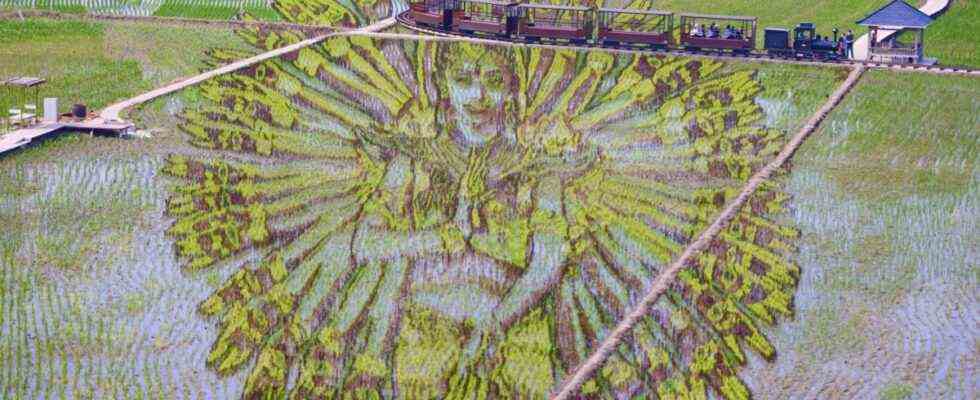There is the wave in the rice field. You can see them from the little hill at the foot of the tower in the old lotus village of Gyoda. The dark stalks stand out clearly from the green ones, so that the contours of a large, breaking sea wave can be seen in the plain. And a little further to the right you can see the national mountain Fuji with its snow-covered top made of lighter plants. But if you want to really see the rice field art, you have to go up to the 50 meter high observation tower of the park. The queue in front of the entrance is long, and an employee of the Lotus Village is counting the people, because of course not too many can look at one of the most beautiful rice fields in Japan from above at the same time.
It is not a good time to be in Japan. The new coronavirus crisis, which began four weeks ago during the Olympics, has grown so large that hospitals have been forced to turn patients down. The number of infections has not only risen sharply in metropolitan areas such as Tokyo, but also in rural prefectures. But maybe that’s why Japan’s rice field art is important now.
Viewed from below, in Gyoda, an hour’s train ride from Tokyo, the dark stalks stand out clearly from the green.
(Photo: Thomas Hahn)
Looking at beautiful things is part of Japanese life like sushi and sake. Hanami, for example, the cherry blossom festival in spring, literally means: looking at blossoms. The boozy hanami parties were banned during the pandemic, but many people in Japan weren’t missing much. Because they could go to the cherry orchards. And when they see the flowers, they don’t think it’s so bad. The rice field art is such a comforting spectacle too.
The rice farmers in Inakadate in the north of Aomori Prefecture started the tradition in 1993. Rice has been grown in Inakadate for over 2100 years. And because the aim was to bring this old farming culture closer to the local elementary school children, the farmers there also sowed rice plants from very old times. They found that these were of different colors than modern plants. So the idea arose to plant the rice varieties in such a way that they become a picture.
Where and which variety has to be sown is now being designed on the computer
The first rice field pictures were a bit rough, but soon the farmers had them drawn up on the computer. The information about where which plants should be sown became more precise, and today the rice field pictures are splendid, detailed works with spatial depth. Other rice locations have adopted the art. Gyoda, a city of 80,000 people, has also been doing this in the fields behind the Lotus Park since 2008. In 2015, the city even got into the Guinness Book of Records because its picture rice field with 2.8 hectares was the largest in the world.
Comforting spectacle: the rice field in Gyoda near Tokyo.
(Photo: Thomas Hahn)
Gyoda is an hour’s train ride from Tokyo. You have to take the bus from the train station. There are lots of cars in the lotus village parking lot. If you want to go to the elevator of the observation tower, you have to wait. Entry is 400 yen, or 3.10 euros. Before you can pay you have to write down your name, address, telephone number and have your fever measured. Pandemic standards. Nobody grumbles, and it’s worth the effort to look at it. The field really looks like a painting in shades of green and brown from above.
“Japanism lives again in the rice fields”
For the past 13 years, Gyoda’s people have always sown a different image in community work. Only in 2020 there was no exhibition because of the pandemic. This year the theme is therefore: “Japanism lives again in the rice fields.” The rice field shows the motifs of the most famous Edo period woodcut by Katsushika Hokusai, the Great Wave of Kanagawa with Mount Fuji in the background from the cycle “36 Views of Mount Fuji”. To do this, you look into the expressive face of a kabuki actor. The visitors stand at the viewing windows and take photos.
The rice field artists from Gyoda have planted the picture together from four different varieties, including a particularly slow-growing one that supposedly enhances the 3-D effect of the depiction. August is the best month to see them. The rice and with it the picture will not be harvested until October. People like it. Kozue Yoshimoto from the Municipal Foundation for Industry, Culture and Sport wrote in the newspaper Mainichi said: “The number of visitors has returned to pre-pandemic levels.” The longing for beautiful fields seems to be greater in Japan than the fear of the virus.

